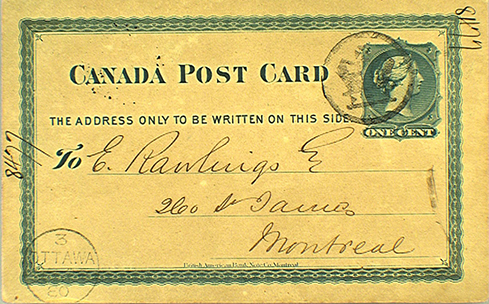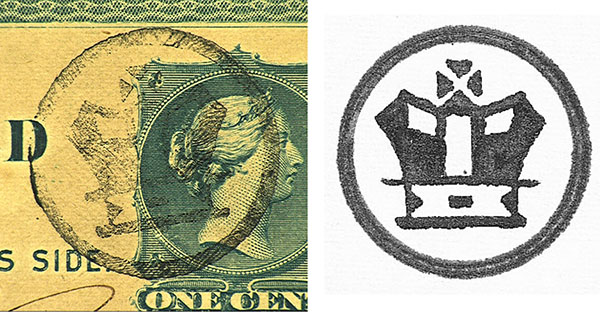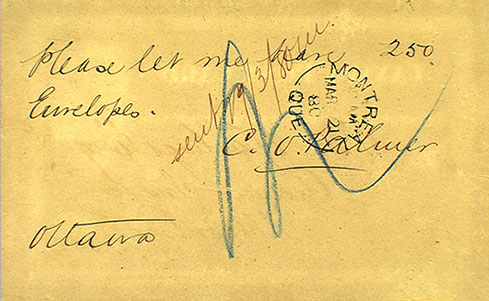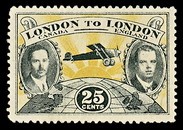
Ottawa Crown Cancels

Here is a Canada Post Card (Scott #UX2) with a decent strike of an Ottawa Crown (Day & Smythies #225). For my write-up and records of fancy cancels, I like the numbering system used by David Lacelle [1]. The cancel is recorded as number 1283 but has a most interesting accompanying note: "A problem child! The illustration is from the P&A proofbook, Feb. ’80. This cancel was supposedly for Ottawa, however there are no genuine strikes known…….PHSC Journal #97, Mar. ’99."
Is this a discovery copy? Is this post card genuine? Is this unique?

Using my home library I discovered that there is little written on the solid black crown cancel. Boggs [2], Jarrett [3], Howe [4] and Lacelle [5] all agree that proof strikes were recorded in February 1880 but nothing is recorded with respect to the use of the device. An internet Google search yielded no useful information.
I retrieved the PHSC Journal number 97 (1999) and read the well researched article, OTTAWA POST OFFICE OFFICIAL HANDSTRUCK FREE MARKINGS, by Daniel B.T. Davis [6]. He states on page 6 "A few strikes of the solid crown, OH-1, have been recorded used in March 1880 on government departmental mail." His chart on page 8 describes the solid crown as "Very rare with fewer than 5 genuine strikes recorded used in March 1880 for government department mail."
My next step was to take advantage of my Greene Foundation affiliation and do a forensic examination of the postcard using the Foster+Freeman VSC6000 and use the imaging capability of the machine to create the accompanying photos.
I compared the post card with others from my collection and am comfortable in stating that the card itself is genuine in all respects. There was no surprise there as these cards are still easily available in unused condition. I also compared the strike with the illustrations in the previously mentioned publications and feel very comfortable stating that the images match.
The receiving mark on the front lower left corner clearly shows the date as March 20, 1880 which is consistent with Daniel Davis’ observations. The only remaining question I could imagine was “Is this government mail?”
We are fortunate in the Greene Foundation to have the services of Kathy Hartley, a librarian who is also a genealogist and who is brilliant at researching people who are long departed. I turned Kathy loose with the names of the addressee and sender to see if we could connect them to government service.
The addressee, E. Rawlings, was Edward Rawlings, Manager & Secretary of THE ACCIDENT INSURANCE COMPANY OF CANADA [7]. This insurer, with its head office at 260 St. James Street in Montreal, provided accident insurance for persons travelling on public conveyances such as trains and ships with the policy being purchased at the time of the ticket purchase.

The sender, identified by his signature on the message side of the card, was Charles O. Palmer who was identified in the Ottawa city directory as an accountant for the Canadian Pacific Railway [8].
Drawing on my past insurance experience, Palmer was writing the insurer requesting a supply of pre-printed envelopes that would be used to remit policy applications and premiums to the insurance company.
So there we have it. The post card was not used in government service but is shown to be a piece of commercial mail which, according to other research, must be unique.
Is this really the only piece of non government commercial mail that was struck using the solid crown cancelling device? I simply cannot imagine that the Ottawa Post Office received a cancelling device that was used only five or six times then retired from service (unless it was lost or became broken or damaged).
References
[1] Fancy Cancels on Canadian Stamps, 1855 to 1950 by David M. Lacelle published by the British North American Philatelic Society Ltd. (2000)
[2] The Postage Stamps and Postal History of Canada by Winthrop S. Boggs, Quarterman Publications Inc, second printing December 1975
[3] Stamps of British North America by Fred Jarrett, Quarterman Publications, 1975
[4] Holmes Specialized Catalogue of Canada and British North America, 11th edition, revised, The Ryerson Press, 1968
[5] ibid
[6] PHSC Journal #97, March 1999, pages 2-21. Article “OTTAWA POST OFFICE OFFICIAL HANDSTRUCK FREE MARKINGS” by Daniel B.T. Davis. Published by the Postal History Society of Canada
[7] Accident Insurance Company of North America Directors found at http://www.rootsweb.ancestry.com/~ote/canada/shareholders_aic.htm
[8] Ottawa directory, 1875 found online at https://archive.org/stream/cihm_46777#page/n163/mode/2up
No.25 The famous "London to London" Semi-Official Airmail - Canada #CLP6, 1927
Aviation and philately have always been closely tied, so it is no wonder that airmail stamps and postal history are so popular. The stamp shown here tells an interesting story.
In 1927, flying across the Atlantic was all the rage. Lindbergh completed a Trans-Atlantic flight in May, but a dozen others lost their lives in other attempts. The world was fascinated by the daring aviators who attempted the dangerous flight. Carling Breweries of London Ontario offered a $25,000 prize to any Canadian or British pilot who could fly non-stop from London Ontario to London England. Since it was not possible to fly that distance on a single load of fuel, the rules were changed to allow a landing in Newfoundland for refueling.
The plane 'Sir John Carling' piloted by Captain Terrence B. Tully and Lieutenant James Medcalf took off from London Ontario on 05 September 1927. After stopping at St. John's Newfoundland, Tully and Medcalf headed across the Atlantic carrying mail franked with a special 25¢ airmail stamp that bore their portraits (#CLP6). The plane never arrived in England. The letters, plane and pilots were all lost at sea, probably off the coast of Newfoundland and no letters bearing these stamps were ever recovered.
In 2010 the stamp, about nine genuine ones known, was featured in an auction sale. The stamp realized $29,900 which turns out to be even more than the prize of $25,000 originally offered for the flight. (fa)
